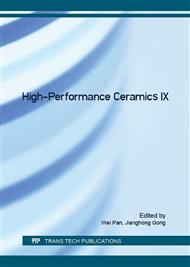p.80
p.84
p.89
p.93
p.97
p.101
p.105
p.109
p.113
La-Doped Nanometer TiO2 Powders Prepared by Sol-Gel Method
Abstract:
La-doped Titania powders were synthesized by sol-gel method. The influence of dopant on the phase transformation temperature, Phase compositions, chemical states, microstructures and the visible light absorbable range of titania were investigated, which were characterized by X-ray diffractometer (XRD), transmission electron microscopy (TEM), energy dispersion X-ray spectrum in scanning transmission electronic microscope (STEM-EDS) and UV-Vis spectrophotometer (UV-Vis). The results show that the dopant of La3+ significantly inhibited the phase transition and grain growth of TiO2.With the increasing of calcination temperature, the grain orientation of TiO2 are from clutter into order and the light absorption band edge of TiO2 are blue shift. La3+-doped titania precipitate La4Ti19O24 and the second phase precipitated on the surface of TiO2 with irregular spherical.
Info:
Periodical:
Pages:
97-100
Citation:
Online since:
July 2016
Authors:
Keywords:
Price:
Сopyright:
© 2016 Trans Tech Publications Ltd. All Rights Reserved
Share:
Citation:


